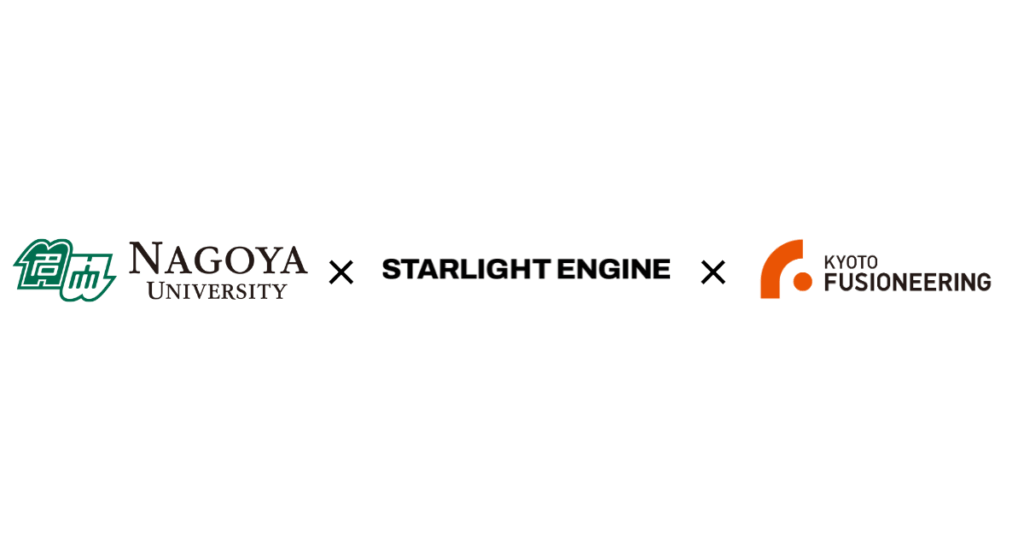Partnering on Plasma Design to Propel the FAST Project toward Fusion Power Generation in the 2030s
Nagoya University, a member of the Tokai National Higher Education and Research System, Starlight Engine Ltd. (SLE), and Kyoto Fusioneering Ltd. (KF) have signed a joint research agreement to collaborate on the plasma design for the FAST Project, an ambitious initiative aimed at achieving fusion power generation in the 2030s.

1. Joint Research Agreement Overview
Launched in November 2024, the FAST Project represents a bold, private-sector-led partnership between industry and academia, with an ambitious goal to demonstrate fusion power generation by the 2030s. Utilizing the tokamak confinement method(*1)—the most thoroughly researched approach to fusion—FAST is strategically positioned to minimize both costs and technical risks, driving rapid progress toward commercialization.
Spearheaded by Starlight Engine (SLE), the project brings together Japan’s top fusion researchers, industrial players like KF, and key international partners, creating a dynamic alliance to propel fusion energy from ambitious vision to reality. Achieving an early, cost-effective demonstration of fusion energy—FAST’s central goal—requires a plasma design that integrates key elements, including confinement performance, heating and current drive, heat management, and particle circulation.
This joint research agreement marks the beginning of a groundbreaking collaboration to advance plasma design, in partnership with Professor Takaaki Fujita of the Department of Applied Energy at Nagoya University. Professor Fujita, a key contributor to the FAST Project, is a world-renowned expert in tokamak plasma design, with a distinguished career that includes playing a pivotal role in the development and operation of JT-60U (*2), the predecessor to the world’s largest superconducting tokamak plasma experiment, JT-60SA (*3). Notably, he led JT-60U to achieve a world-first effective energy gain (Q > 1) and later took charge of plasma design for JT-60SA. His research at Nagoya University continues to push the boundaries of plasma simulation and fusion reactor design, further solidifying his status as a leading figure in the field.
By combining Professor Fujita’s unparalleled expertise with the cutting-edge engineering capabilities and project execution strengths of Kyoto Fusioneering and Starlight Engine, the FAST Project is poised to make significant progress on the path toward realizing fusion energy. This collaboration stands as a critical step toward bringing fusion power from concept to reality.
2. Joint Research Agreement Details
This joint research effort will tackle one of the most critical components of the FAST project—the development and design of advanced plasma systems. The research team will examine optimal plasma parameters through a comprehensive approach, considering both plasma physics and reactor engineering, while designing the necessary equipment to generate and sustain the core plasma.
Specifically, the research will involve calculating plasma shape, density distribution, and temperature distribution to estimate fusion output and guide the design of surrounding systems. In parallel, the team will work on optimising plasma operation scenarios, from the initial plasma startup to achieving steady-state operation, as well as developing plasma control strategies to ensure stable and sustained operations.
3. Comments from Project Leaders
Professor Takaaki Fujita – Department of Applied Energy, Graduate School of Engineering, Nagoya University
“I’m excited to be playing a pivotal role in the FAST Project, a groundbreaking initiative aimed at sustaining fusion reactions and generating electricity from fusion energy by the 2030s. Drawing on my background as a researcher, I hope to leverage my expertise in plasma design to help shape and optimize the device design, bringing us closer to a future powered by fusion.”
Kiyoshi Seko – CEO, Starlight Engine Ltd.
“We are looking forward to collaborating on the FAST Project with two highly knowledgeable and specialized partners—Nagoya University and Kyoto Fusioneering. With Professor Fujita’s decades of expertise in plasma research, we are excited to enhance the design of FAST and accelerate progress toward demonstrating power generation, ultimately paving the way for the commercialization of fusion energy.”
Satoshi Konishi – Co-Founder and CEO, Kyoto Fusioneering Ltd.
“We’re excited and honored to be part of the FAST Project, led by Starlight Engine, alongside Professor Fujita, a recognized expert in both the physics and engineering design of tokamak plasmas. By applying our core strength in plant engineering to the crucial task of plasma design, we’re committed to advancing the demonstration of fusion power generation in the 2030s, bringing us closer to the practical realization of fusion energy.”
*1: A fusion reactor concept that uses magnetic fields to contain high-temperature plasma. A donut-shaped (toroidal) magnetic field is formed by combining two types of magnetic fields—toroidal and poloidal—enabling stable confinement of the high-temperature plasma within.
*2: JT-60U (Upgrade) was one of the world’s largest tokamak fusion experimental devices. It achieved significant milestones, including reaching critical plasma conditions—where the energy input equals the energy generated by fusion reactions—and setting record-high ion temperatures. Experimental operations concluded in August 2008, but its legacy continues through the JT-60SA device.
*3: JT-60SA is the world’s largest superconducting tokamak plasma experimental device, located at the National Institutes for Quantum Science and Technology (QST) in Naka, Ibaraki Prefecture, Japan. It is a collaborative project between Japan and Europe.




